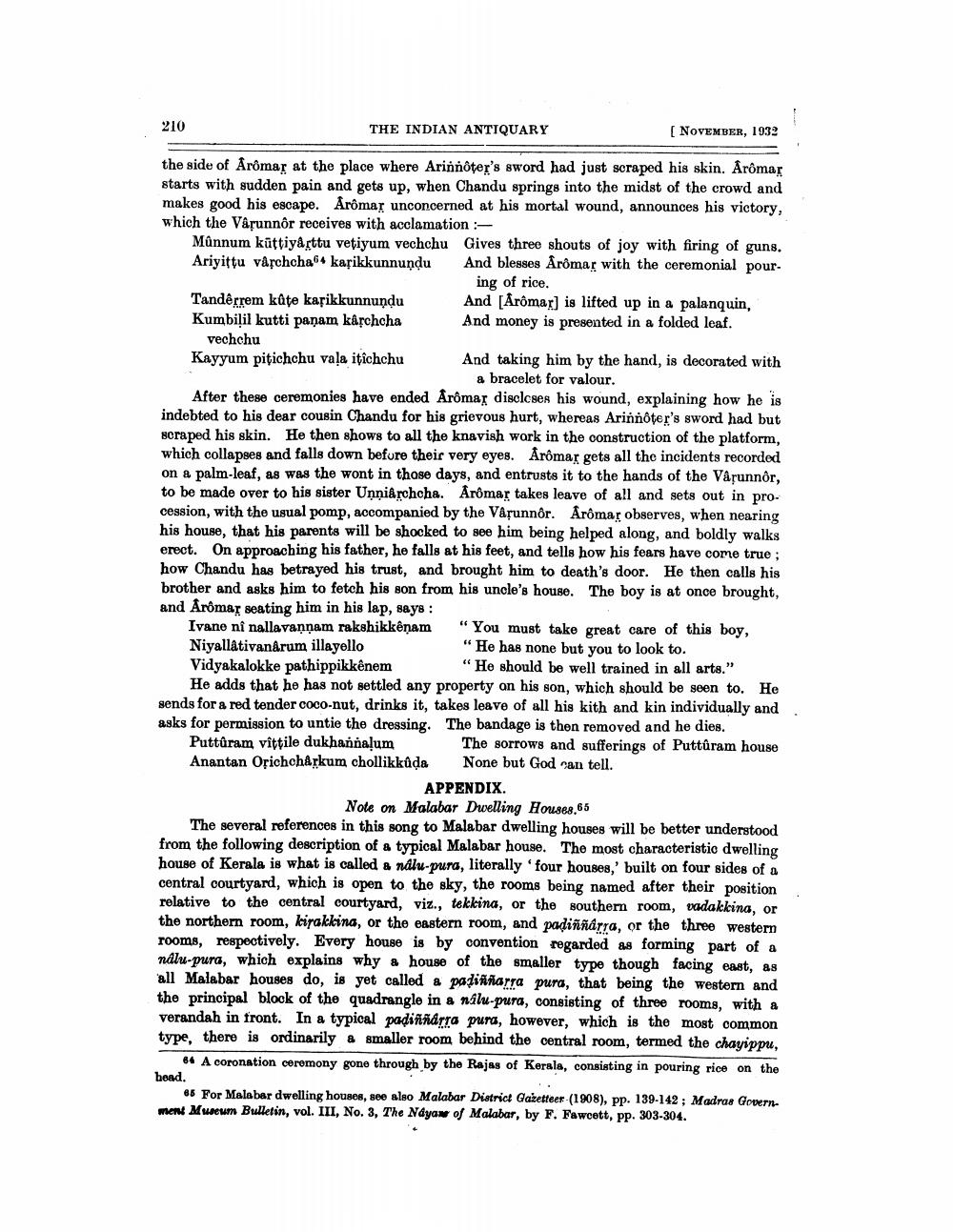________________
210
THE INDIAN ANTIQUARY
NOVEMBER, 1932
the side of Arômar at the place where Ariñnoter's sword had just scraped his skin. Arômar starts with sudden pain and gets up, when Chandu springs into the midst of the crowd and makes good his escape. Arômar unconcerned at his mortal wound, announces his victory, which the Vârunnôr receives with acclamation :
Mûnnum küttiyârttu vetiyum vechchu Gives three shouts of joy with firing of guns. Ariyittu vârchcha karikkunnundu And blesses Arômar with the ceremonial pour
ing of rice. Tandêrrem kate karikkunnundu And [Arómar) is lifted up in a palanquin, Kumbilil kutti panam kârchcha And money is presented in a folded leaf.
vechchu Kayyum pitichchu vaļa itichchu And taking him by the hand, is decorated with
a bracelet for valour. After these ceremonies have ended Arômar discloses his wound, explaining how he is indebted to his dear cousin Chandu for his grievous hurt, whereas Ariñnoter's sword had but scraped his skin. He then shows to all the knavish work in the construction of the platform, which collapses and falls down before their very eyes. Arômar gets all the incidents recorded on a palm-leaf, as was the wont in those days, and entrusts it to the hands of the Vasunnor, to be made over to his sister Uņni&rchcha. Arómar takes leave of all and sets out in procession, with the usual pomp, accompanied by the Vârunnôr. Arômar observes, when nearing his house, that his parents will be shocked to see him being helped along, and boldly walks erect. On approaching his father, he falls at his feet, and tells how his fears have come true; how Chandu has betrayed his trust, and brought him to death's door. He then calls his brother and asks him to fetch his son from his uncle's house. The boy is at once brought, and Arómar seating him in his lap, says:
Ivano ni nallavannam rakshikkênam “You must take great care of this boy, Niyallativanârum illayello
"He has none but you to look to. Vidyakalokke pathippikkenem
“He should be well trained in all arts.” He adds that he has not settled any property on his son, which should be seen to. He sends for a red tender Coco-nut, drinks it, takes leave of all his kith and kin individually and asks for permission to untie the dressing. The bandage is then removed and he dies. Puttûram vittile dukhannalum
The sorrows and sufferings of Puttûram house Anantan OřichchArkum chollikkûda None but God nan tell.
APPENDIX.
Note on Malabar Dwelling House8.65 The several references in this song to Malabar dwelling houses will be better understood from the following description of a typical Malabar house. The most characteristic dwelling house of Kerala is what is called & ndlu-pura, literally "four houses,' built on four sides of a central courtyard, which is open to the sky, the rooms being named after their position relative to the central courtyard, viz., teklina, or the southern room, vadakkina, or the northern room, kipakkina, or the eastern room, and padiññárra, or the three western rooms, respectively. Every house is by convention regarded as forming part of a ndlu-pura, which explains why a house of the smaller type though facing east, as all Malabar houses do, is yet called & padiifarra pura, that being the western and the principal block of the quadrangle in a nilu-pura, consisting of three rooms, with a verandah in front. In a typical padinndrra pura, however, which is the most common type, there is ordinarily & smaller room behind the central room, termed the chayippu,
64 A coronation ceremony gone through by the Rajas of Kerala, consisting in pouring rice on the head.
66 For Malabar dwelling houses, see also Malabar District Gazetteer -(1908), pp. 139-142; Madras Government Museum Bulletin, vol. III, No. 3, The Nayaw of Malabar, by F. Fawcett, pp. 303-304.




